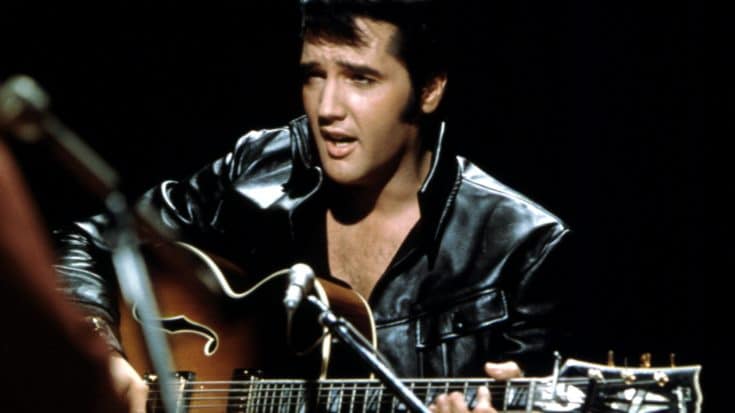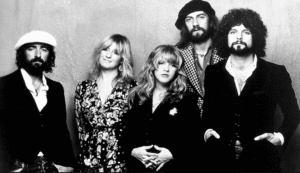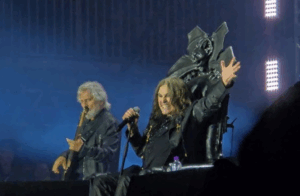Celebrities That Survived Infamous Events In History

BURBANK, CA - JUNE 27: Rock and roll musician Elvis Presley performing on the Elvis comeback TV special on June 27, 1968. (Photo by Michael Ochs Archives/Getty Images)
Being a celebrity comes with a lot of perks—fame, fortune, red carpets, and front-row access to the best life has to offer. Whether they’re stars of the screen, stage, sports, or politics, these people often seem to live in a world far removed from the everyday. They have the talent, charm, and drive to rise above the crowd and become household names.
But when disaster strikes, no amount of fame can shield them. Just like anyone else, celebrities face the same dangers, heartbreaks, and sudden turns that life can throw. Natural disasters, tragic accidents, and shocking world events don’t spare the famous, and when they’re caught in the middle of it, their stories have a way of bringing those moments closer to the rest of us.
We’re naturally curious about the lives of the rich and famous—but when they go through something traumatic, it reminds us that they’re human too. These stars didn’t just survive disaster—they shared what it was like to live through it.
Elvis Presley Survived One of America’s Deadliest Tornadoes
Long before he became the King of Rock ’n’ Roll, Elvis Presley was just a baby growing up in Tupelo, Mississippi. On April 5, 1936, that small town was hit by one of the deadliest tornadoes in U.S. history—an F5 monster known as the “Tupelo Tornado.” Part of a massive storm system that tore across the Southeast, the twister killed over 200 people in Tupelo alone and left more than 1,000 injured. Homes were destroyed, the hospital was hit, and even the town’s water supply was wiped out.
Elvis was just 15 months old at the time, living with his parents in a tiny house in Tupelo. As the storm ripped through town, the Presley family huddled inside—and somehow, their home was untouched. While much of the town was flattened, their house remained standing. Remarkably, their survival wasn’t the only connection to history—Tupelo’s mayor at the time was Elvis’s great-uncle, Noah Presley. The King’s life may have only just begun, but he’d already lived through a once-in-a-generation disaster.
Travis Barker’s Near-Death Escape from a Fiery Plane Crash
In September 2008, Blink-182 drummer Travis Barker was flying home from a show in South Carolina with his side project TRVSDJ-AM, which he performed with DJ AM (Adam Goldstein). After playing a free gig at the University of South Carolina, the duo boarded a small jet at Columbia Metropolitan Airport. But moments after takeoff, disaster struck. The plane shot off the runway, slammed into a barrier, and burst into flames.
Four people were killed instantly—Barker’s close friends and crew members Charles Still and Chris Baker, along with pilots Sarah Lemmon and James Bland. Only Barker and DJ AM survived the crash.
Barker recalled the terrifying moment on The Joe Rogan Experience, saying, “I jumped right into the jet, which is full of fuel. My whole body lit up. I had jet fuel on my whole body.” He was rushed to a burn center in Georgia with severe burns covering two-thirds of his body.
It took 26 surgeries, skin grafts, and three long months of rehab before he could walk again. Barker not only survived—he eventually returned to the stage, scarred but unstoppable.
Jack Russell and the Night of Rock’s Deadliest Concert Fire
On February 20, 2003, what should have been a typical night of ’80s rock nostalgia turned into one of the deadliest concert tragedies in U.S. history. Jack Russell’s Great White—a spinoff of the original hair metal band—was playing a small gig at The Station nightclub in West Warwick, Rhode Island. Over 400 fans packed the venue, unaware of the nightmare to come.
Despite warnings from venue staff, the band’s tour manager set off pyrotechnics at the back of the stage. Within seconds, flames erupted, quickly engulfing the club. Singer Jack Russell tried to douse the fire with water but soon realized it was out of control. The band escaped through a stage door, but for many inside, there was no way out. Two of the four exits were blocked, and panic set in as fans rushed toward the only accessible door.
The fire claimed 100 lives. In the documentary America’s Deadliest Concert: The Guest List, Russell reflected, “It was just a horrible, horrible tragedy, and I wish I could go back and cancel that show.”
Sarah Ferguson Narrowly Escaped the 9/11 Attacks
After divorcing Prince Andrew in 1996, Sarah Ferguson—formerly the Duchess of York—stepped away from royal life and focused on charitable work. One of the causes closest to her heart was Chances for Children, a nonprofit she co-founded, which had its U.S. office on a high floor in the North Tower of the World Trade Center in New York City.
On the morning of September 11, 2001, Ferguson was scheduled to attend an 8:45 a.m. meeting at the office. But as fate would have it, she was running just a bit late. Her car pulled up outside the World Trade Center at 8:47 a.m.—just moments after American Airlines Flight 11 crashed into the North Tower.
Because of her delay, the Chances for Children team hadn’t yet gone upstairs. They were in the lobby, waiting for Ferguson to arrive. When the plane hit, she acted fast, helping her staff pile into her car and get out of the area. Her lateness may have very well saved lives that day.
How a Broken Pair of Glasses Saved Chef Michael Lomonaco on 9/11
Michael Lomonaco was a star in New York City’s culinary world, known for his work at iconic spots like Le Cirque and 21 Club. In 1997, he became the culinary director at Windows on the World, the famous fine dining restaurant perched on the 106th and 107th floors of the North Tower of the World Trade Center.
On the morning of September 11, 2001, Lomonaco arrived earlier than usual—around 8:30 a.m.—and decided to stop by the shopping level of the WTC to get his eyeglasses repaired. While waiting, at exactly 8:46 a.m., he felt a violent shake. “I just thought, ‘Could that be the subway?’” he told MarketWatch. It wasn’t—it was the first plane crashing into the tower.
The power went out, and Lomonaco quickly left the building, witnessing debris raining down from above—right near where his restaurant was located. He tried to return to help his staff, but before he could, he looked up and saw the second plane hit. That optometry stop likely saved his life.
Nate Berkus and the Tragedy That Changed His Life
Nate Berkus is one of the few interior designers to achieve celebrity status. Known for his work on HGTV, his own talk show, and popular home collections, Berkus built a career on beauty and design. But behind his success is a heartbreaking story tied to one of the worst natural disasters in modern history.
On December 26, 2004, a massive 9.1-magnitude earthquake struck beneath the Indian Ocean, triggering the deadly Boxing Day Tsunami. The waves hit coastal areas across Southeast Asia at terrifying speed—up to 500 miles per hour—killing more than 100,000 in Indonesia and over 5,000 in Thailand.
Berkus was vacationing with his partner, photographer Fernando Bengoechea, in Arugam Bay, Sri Lanka, when the tsunami hit. Berkus survived with minor injuries, but Bengoechea was swept away by the waves. His body was never found, and he was presumed dead—one of thousands who simply vanished.
“I had scars. I have scars still, not extensive,” Berkus told People. “But if you know, you know.” The experience left an emotional mark that Berkus carries with him to this day.
Jet Li’s Close Call with the 2004 Tsunami
Jet Li, known worldwide for his martial arts skills and action-packed films like Hero, Romeo Must Die, Mulan, and The Expendables, had a terrifying brush with death during the 2004 Boxing Day Tsunami.
Li had just arrived at the luxurious Four Seasons resort in the Maldives with his daughters and their nanny, only hours before the tsunami hit. Triggered by a powerful 9.1-magnitude earthquake beneath the Indian Ocean, the tidal waves swept across coastal regions in Southeast Asia, destroying everything in their path.
Having lived through earthquakes before, Li sensed something was off but went about his day. About two hours later, he took his daughters to the beach. “We were just outside the hotel, by the pool and slightly above the beach, when I saw the water come,” he told Newsweek. As he and the nanny grabbed the children and tried to flee, a wave pulled them underwater. “I turned back, and everything — the beach, the swimming pool — was gone.” Four men nearby rushed in and pulled them to safety, saving their lives just in time.
Jesse Hughes Survived the Deadly Bataclan Concert Attack
On November 13, 2015, Paris was rocked by a series of coordinated terrorist attacks carried out by ISIS. The horror began around 9:20 p.m., when bombs exploded at the Stade de France. At the same time, gunmen opened fire on diners at cafes and restaurants across the city. But the deadliest strike happened at the Bataclan concert hall, where 1,500 fans had gathered for a sold-out show by the American rock band Eagles of Death Metal.
Frontman Jesse Hughes and his band were onstage when three armed attackers stormed the venue, firing into the crowd. Chaos erupted. Hughes and the band rushed backstage, hoping to find cover. But in a hallway, Hughes came face-to-face with one of the gunmen. “I thought I was dead, I just waited for the shots to hit me,” he later told Sweden’s TV4 (via NBC News). Miraculously, he wasn’t shot and managed to escape.
Tragically, 89 people were killed at the Bataclan, including the band’s merch manager, Nick Alexander, and three label reps. Across all the attacks in Paris that night, 130 lives were lost, and 352 people were injured.
Eleanor Roosevelt Survived a Deadly Shipwreck as a Child
Long before she became the longest-serving First Lady in U.S. history, Eleanor Roosevelt had a brush with death at just two years old. Born into two powerful political families—her father was the brother of President Theodore Roosevelt—Eleanor grew up with access to luxury, including overseas travel aboard grand ocean liners.
In May 1887, she boarded the SS Britannic with her parents, setting sail from New York to Liverpool. But just over 300 miles off the New Jersey coast, disaster struck. As the ship moved through heavy fog, it collided almost head-on with another White Star Line vessel, the Celtic. The Celtic’s sharp bow tore 10 feet into the side of the Britannic, causing a deadly crash that killed six people in steerage and left six more lost at sea.
A young Eleanor, reportedly crying and refusing to leave without being placed in a lifeboat, survived the ordeal. The traumatic experience left a mark—she carried a deep fear of water for the rest of her life.
Charles Nelson Reilly Escaped a Circus Fire That Killed 170 People
Long before he became a familiar face on game shows and sitcoms, a young Charles Nelson Reilly experienced a terrifying brush with death. At just 13 years old, he was in the audience of the Ringling Brothers Barnum and Bailey Circus during a tent show in Hartford, Connecticut, on July 6, 1944.
As the Great Wallendas were performing their high-wire act, a fire suddenly broke out near the men’s restroom—likely sparked by a discarded cigarette that ignited the tent’s outer canvas. Unfortunately, the tent had been waterproofed with a dangerous mix of paraffin wax and gasoline, making it highly flammable. Within minutes, the fire spread rapidly.
As panic set in, thousands of screaming spectators rushed to escape, but many exits were blocked by animal cages. Flaming canvas rained down, and chaos overtook the tent. In less than 10 minutes, the big top was gone, and 170 people had died from burns, smoke inhalation, or being crushed in the stampede.
Reilly survived, but the trauma stayed with him—he reportedly never attended another circus again.
Alex Chilton Rode Out Hurricane Katrina—and Barely Survived
Alex Chilton shot to fame as a teen in 1967 with the Box Tops’ chart-topping hit “The Letter.” Later, he co-founded Big Star, a critically loved but commercially overlooked band that would become a cult favorite. After growing disillusioned with the music business, Chilton left Nashville and moved to New Orleans in 1982. He settled into a quieter life, working odd jobs and playing in bar bands, eventually buying a weathered 19th-century Creole cottage in the Tremé neighborhood.
When Hurricane Katrina tore through New Orleans in August 2005, Tremé was hit hard by intense winds and flooding. Chilton’s home, raised above the ground, avoided floodwaters but wasn’t spared from the storm’s fury. The exterior was badly damaged by high winds.
Chilton chose not to evacuate, boarding up his windows and staying put to guard against looters. But after five days without food or help—and feeling increasingly scared and isolated—he climbed onto his roof and waved for help. A helicopter finally spotted him and airlifted him to safety, ending a harrowing ordeal that nearly cost him his life.
Fats Domino Was Rescued from Katrina After Being Presumed Dead
Fats Domino, one of the founding fathers of rock ’n’ roll, was also one of the many New Orleans residents who endured the devastation of Hurricane Katrina in 2005. Famous for classics like “Ain’t That a Shame,” “Blueberry Hill,” and “I’m Walkin’,” Domino was a lifelong resident of the city he helped put on the musical map.
When Katrina hit, Domino was living in the Lower Ninth Ward—one of the hardest-hit areas. Despite the danger, he refused to leave, choosing to stay behind and care for his ill wife, Rosemary. As floodwaters rose and communication lines went down, friends and fans feared the worst. At one point, a message was spray-painted on his home that read, “RIP Fats. You will be missed,” leading to widespread reports that the music legend had died.
But hours later, CNN confirmed that Fats Domino was alive. He had been rescued by the U.S. Coast Guard, airlifted from his flooded home to safety—proof that even legends can be caught in chaos and still find a way through.
John Davidson Escaped—and Helped Others Escape—a Deadly Club Fire
On May 28, 1977, over 1,200 people—twice the legal capacity—crowded into the Beverly Hills Supper Club near Cincinnati to see singer and TV host John Davidson perform. Known for his Broadway roles and The John Davidson Show, he was the night’s headliner. But before he could take the stage, tragedy struck.
As the opening act, a ventriloquist duo, performed, an electrical fire started in the Zebra Room, a closed-off area of the club. Thick smoke and toxic fumes quickly spread toward the packed Cabaret Room. A busboy interrupted the show to tell the audience to evacuate—but many thought it was part of the act.
Chaos followed. People scrambled to escape, but the overcrowded room and limited exits made it nearly impossible. Davidson stayed calm and helped guide fans to safety, holding open a little-used rear door. “I was one of the lucky ones that got out through a door that was just put in the year before,” he told WKRC-TV.
Davidson lost his musical director in the fire and was left to identify his body. “It changed my life,” he said. That night, 165 people died—making it one of the deadliest nightclub fires in U.S. history.
Melissa McCarthy Survived a Devastating F5 Tornado in Her Hometown
Long before her rise to fame in movies and TV, Melissa McCarthy experienced a terrifying brush with nature’s fury. On August 28, 1990, an F5 tornado ripped through Plainfield, Illinois—McCarthy’s hometown. With wind speeds topping 300 miles per hour, the storm carved a 16-mile path of destruction, killing 29 people, injuring 350, and leveling entire neighborhoods.
McCarthy, home from college for the weekend, was hanging out at a friend’s townhouse when the tornado struck. “We were sitting on the couch in front of patio windows,” she recalled on Hot Ones. “I don’t remember what happened, but I think it must have been a pressure change.” Her friend suddenly grabbed her by the shirt and dragged her toward the basement stairs.
They took cover in the cellar, and within minutes, the storm passed. When they came back up, they were stunned—the windows were shattered, the top floor was gone, and their entire block had been destroyed. It was a moment McCarthy would never forget—and one that nearly cost her life.
Yogi Berra Was a D-Day Hero Before Becoming a Yankees Legend
Before he became a beloved baseball icon, Yogi Berra was a real-life war hero. Known for his 18-season career with the New York Yankees—where he racked up 10 World Series titles and three MVP awards—Berra’s MLB debut was delayed by something far bigger than baseball: World War II.
At just 19, Berra joined the U.S. Navy and was selected as one of six men trained to operate a rocket-launching craft for the D-Day invasion. On June 6, 1944, during the Allied assault on Normandy’s beaches, Berra’s mission was to help clear the way for 150,000 troops storming France to liberate it from Nazi control.
From his craft, Berra fired on German machine-gun nests, helping secure the beach for the advancing soldiers. It was a critical, high-risk operation—more than 12,000 Allied troops were killed, injured, or captured that day. But Berra survived, and later took part in another major campaign to liberate southern France.
Long before he was a Yankee legend, Yogi Berra was already a true American hero.
How John F. Kennedy Became a War Hero Before the White House
Before he became the 35th President of the United States, John F. Kennedy proved his courage on the front lines of World War II. At just 24 years old, before America officially entered the war, Kennedy joined the U.S. Navy and steadily rose through the ranks to become a Lieutenant, Junior Grade. He was eventually placed in command of a patrol torpedo boat—PT 109—used in fast-paced, dangerous naval missions.
In April 1943, Kennedy took command of PT 109, and by summer, his crew was helping in the invasion of New Georgia in the Solomon Islands. On the night of August 1, their mission turned into a nightmare. The Japanese destroyer Amagiri rammed PT 109, splitting the boat in two and launching the crew into the water.
Two men were killed, and many others were injured. Among them was engineer Patrick McMahon, badly burned. Kennedy didn’t hesitate—he grabbed McMahon’s life vest strap in his teeth and swam for hours, pulling his injured crewmate to safety. It was a defining moment of bravery for the future president.
Robert Clary Survived the Holocaust Before Playing a POW on TV
From 1965 to 1971, Robert Clary made audiences laugh as Corporal Louis LeBeau on Hogan’s Heroes, a sitcom set in a German POW camp during World War II. The show found unexpected comedy in a grim setting—but for Clary, the role hit incredibly close to home.
Clary was born in France and, like his character, lived through the horrors of Nazi occupation. As a Jewish teenager in Paris, he was arrested when the Nazis seized control and was sent to a slave labor camp in Germany. There, he was forced to make shoes while dodging bombs from Allied air raids. He later endured the brutal conditions of the Buchenwald concentration camp, where nearly 56,000 people were killed.
His talent as a singer and accordion player spared him, as Nazi officers used him for entertainment. “Singing, entertaining, and being in kind of good health at my age, that’s why I survived,” Clary told The Hollywood Reporter. Near war’s end, Clary was forced into a deadly 4,000-person march—only 1,500 survived. His story is one of unimaginable resilience behind a smile that millions would come to know on screen.
Ben Cauley Was the Sole Survivor of the Plane Crash That Killed Otis Redding
On December 9, 1967, soul legend Otis Redding was on the rise. Just days after recording his now-iconic song “(Sittin’ On) The Dock of the Bay,” he boarded a small plane with his band, the Bar-Kays, to perform on the TV show Upbeat in Cleveland. After that, they planned to fly to Madison, Wisconsin, for their next gig.
Tragically, they never made it. Just four miles from the Madison Municipal Airport, the plane went down in the icy waters of Lake Monona. Redding, only 26, died in the crash, along with the pilot, a road manager, and four members of the Bar-Kays. The only survivor was trumpet player Ben Cauley.
Cauley later recalled waking up in the freezing water, clinging to a seat cushion as he watched the wreckage sink. Miraculously, he was rescued and lived to tell the heartbreaking story. Bassist James Alexander was the only other Bar-Kays member not on board—he had flown separately. The crash devastated the soul music world, but thanks to Cauley, a piece of that story lived on.
Betsy Drake Survived the Sinking of the Andrea Doria
Actress Betsy Drake had already lived a dramatic life before she found herself in a real-life disaster at sea. A rising star in London’s theater scene, Drake traveled to the U.S. aboard the Queen Mary in 1947—where she famously deflected romantic advances from Cary Grant. That didn’t last long. Grant tracked her down in New York, and the two began a whirlwind relationship, eventually marrying in 1949 and starring in films like Every Girl Should Be Married and Room for One More.
In the mid-1950s, Drake stepped away from acting. While visiting Grant on the set of The Pride and the Passion in Spain, she suspected he was having an affair with co-star Sophia Loren. Heartbroken, she booked passage home on the Italian ocean liner Andrea Doria.
On the foggy night of July 25, 1956, off the coast of Nantucket, the Andrea Doria collided with another ship, the M.S. Stockholm. Drake was in her cabin reading when the crash happened. She grabbed a life vest and calmly made her way to an upper deck. She was among the 1,660 rescued—narrowly avoiding becoming one of the 46 who didn’t survive.


















